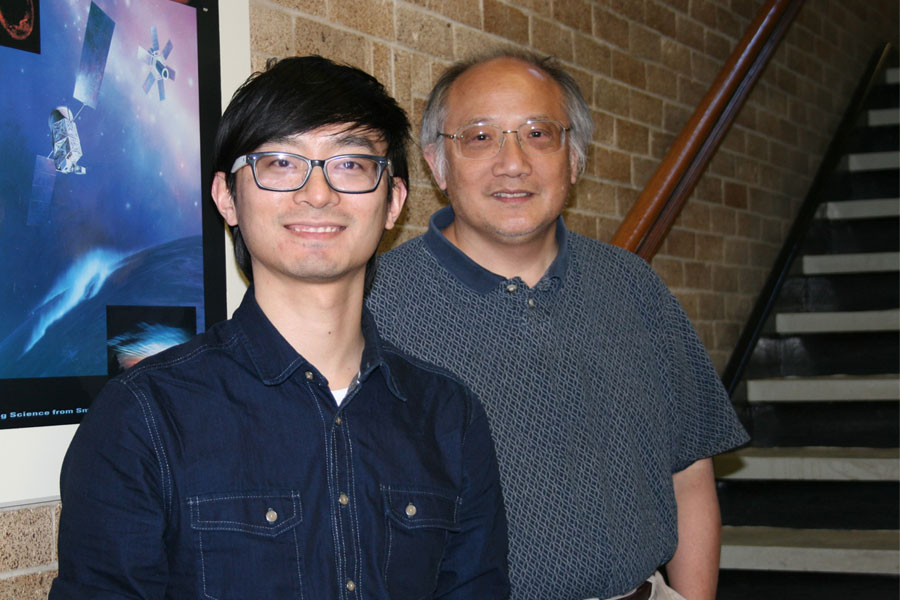
Searching for the rules governing glass
Materials scientists Min Wu and John Tse have solved a small piece of a puzzle that has perplexed researchers for years: the structure of glass, or more precisely, metallic glass.
By Michael Robin
Metallic glasses are made by cooling molten metal extremely quickly, before crystals can form. They have useful properties such as superior strength, toughness, resilience (springiness) and resistance to wear and corrosion. While the challenge of manufacturing metallic glasses has limited their use, they have found their way into products such as high-performance golf clubs.
Tse, a professor in the Department of Physics and Engineering Physics, postdoctoral fellow Wu and their colleagues in the United States and China recently added to understanding of the materials with their discovery of how a certain metallic glass – an alloy of cerium and aluminum —collapses into the more familiar, crystalline state when subjected to high pressure. A similar process creates diamonds, which start off as carbon and are transformed into crystal form under intense heat and pressure.
The team ran simulations using the high-performance computing available through Canada's WestGrid program, of which the University of Saskatchewan is a member.
"The key is we now have good computational models and facilities," Tse said. "The same calculations could not have been done 10 years ago. We just didn't have computers fast enough to do it."
The first step was reproducing real-world observations. Wu, who completed his PhD under the tutelage of Tse and metallic glass specialist J.Z. Jiang from Zhejiang University in China, pushed the analysis further to shed light on how the disordered glass transformed into the usual, ordered crystalline solid.
It turns out that the cerium and aluminum in the alloy compress at different rates, Tse explained, using the analogy of the atoms as balls. This determines the end structure.
"If you have a two-component system, the size of the ‘ball,' in that sense, is not uniform," he said. "One compresses faster than the other. At some point, some become very small and some become very big, and the crystalline structure is determined by the big ‘balls.'"
Tse said the findings, published in Nature Communications, changes the common perception that atoms of elements are always the same size.
"People always think some atoms are always smaller and some atoms are always bigger," he said. "Under compression, you have to modify this thinking."
While the possibilities of metallic glasses are tantalizing—products could achieve the same strength with one-fifth the weight, for example—Tse cautioned that their findings are a small step.
They have only just begun mapping out the rules by which materials become glass or crystallize, but the latest discovery provides new insight into what those rules might be, he said. These would in turn be valuable tools to predict the properties of new alloys.
"This is the first step," he said. "We hope in the long run we can establish some at least pretty good rules, observations, and guiding concepts."
Tse, a professor in the Department of Physics and Engineering Physics, postdoctoral fellow Wu and their colleagues in the United States and China recently added to understanding of the materials with their discovery of how a certain metallic glass – an alloy of cerium and aluminum —collapses into the more familiar, crystalline state when subjected to high pressure. A similar process creates diamonds, which start off as carbon and are transformed into crystal form under intense heat and pressure.
The team ran simulations using the high-performance computing available through Canada's WestGrid program, of which the University of Saskatchewan is a member.
"The key is we now have good computational models and facilities," Tse said. "The same calculations could not have been done 10 years ago. We just didn't have computers fast enough to do it."
The first step was reproducing real-world observations. Wu, who completed his PhD under the tutelage of Tse and metallic glass specialist J.Z. Jiang from Zhejiang University in China, pushed the analysis further to shed light on how the disordered glass transformed into the usual, ordered crystalline solid.
It turns out that the cerium and aluminum in the alloy compress at different rates, Tse explained, using the analogy of the atoms as balls. This determines the end structure.
"If you have a two-component system, the size of the ‘ball,' in that sense, is not uniform," he said. "One compresses faster than the other. At some point, some become very small and some become very big, and the crystalline structure is determined by the big ‘balls.'"
Tse said the findings, published in Nature Communications, changes the common perception that atoms of elements are always the same size.
"People always think some atoms are always smaller and some atoms are always bigger," he said. "Under compression, you have to modify this thinking."
While the possibilities of metallic glasses are tantalizing—products could achieve the same strength with one-fifth the weight, for example—Tse cautioned that their findings are a small step.
They have only just begun mapping out the rules by which materials become glass or crystallize, but the latest discovery provides new insight into what those rules might be, he said. These would in turn be valuable tools to predict the properties of new alloys.
"This is the first step," he said. "We hope in the long run we can establish some at least pretty good rules, observations, and guiding concepts."

